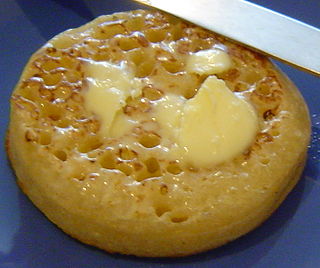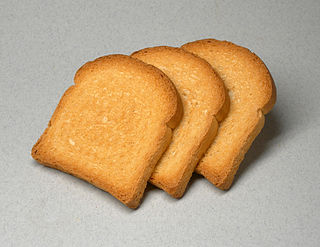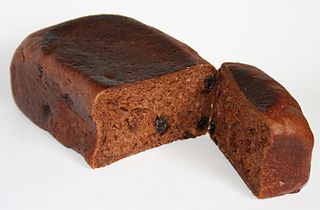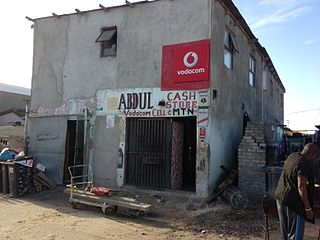
A submarine sandwich, commonly known as a sub, hoagie, hero, Italian, grinder, wedge, or a spuckie, is a type of American cold or hot sandwich made from a cylindrical bread roll split lengthwise and filled with meats, cheeses, vegetables, and condiments.

A convenience store, bodega, convenience shop, corner store or corner shop is a small retail store that stocks a range of everyday items such as coffee, groceries, fruits, vegetables, snacks, confectionery, soft drinks, ice creams, tobacco products, lottery tickets, over-the-counter drugs, toiletries, newspapers and magazines. In some jurisdictions, convenience stores are licensed to sell alcoholic drinks, although many jurisdictions limit such beverages to those with relatively low alcohol content, like beer and wine. The stores may also offer money order and wire transfer services, along with the use of a fax machine or photocopier for a small per-copy cost. Some also sell tickets or recharge smart cards, e.g. OPUS cards in Montreal or include a small deli. They differ from general stores and village shops in that they are not in a rural location and are used as a convenient supplement to larger stores.

A Dagwood sandwich is a tall, multilayered sandwich made with a variety of meats, cheeses, and condiments. It is named after Dagwood Bumstead, a central character in the comic strip Blondie, who is frequently illustrated making enormous sandwiches. According to Blondie scripter Dean Young, his father, Chic Young, began drawing the huge sandwiches in the comic strip during 1936.

A po' boy is a sandwich originally from Louisiana. It almost always consists of meat, which is usually roast beef, chicken fingers or some sort of fried seafood such as shrimp, crawfish, fish, oysters or crab. The meat is served on New Orleans French bread, known for its crispy crust and fluffy center.

in Austria and the Swabian, Bavarian and Franconian parts of Germany, 'leverkaas' in the Netherlands and Fleischkäse ("meat-cheese") in Saarland, Baden, Switzerland and Tyrol) is a specialty food found in the south of Germany, in Austria and parts of Switzerland, similar to bologna sausage. It consists of beef, pork and bacon and is made by grinding the ingredients very finely and then baking it as a loaf in a bread pan until it has a crunchy brown crust. Variations may be made using other kinds of meat such as horse meat or turkey, or may contain additional ingredients such as cheese or minced chili peppers.

A crumpet is a small griddle bread made from an unsweetened batter of water or milk, flour, and yeast, popular in the United Kingdom, Canada, New Zealand, South Africa and Australia.

A cupcake (AmE), fairy cake (BrE), or bun (IrE) is a small cake designed to serve one person, which may be baked in a small thin paper or aluminum cup. As with larger cakes, frosting and other cake decorations such as fruit and candy may be applied.

A rusk is a hard, dry biscuit or a twice-baked bread. It is sometimes used as a teether for babies. In some cultures, rusk is made of cake, rather than bread: this is sometimes referred to as cake rusk. In the UK, the name also refers to a wheat-based food additive.

South African cuisine reflects the diverse range of culinary traditions embodied by the various communities that inhabit the country. Among the indigenous peoples of South Africa, the Khoisan foraged over 300 species of edible food plants, such as the rooibos shrub legume, whose culinary value continues to exert a salient influence on South African cuisine. Subsequent encounters with Bantu pastoralists facilitated the emergence of cultivated crops and domestic cattle, which supplemented traditional Khoisan techniques of meat preservation. In addition, Bantu-speaking communities forged an extensive repertoire of culinary ingredients and dishes, many of which are still consumed today in traditional settlements and urban entrepôts alike.

Bunny chow, often referred to simply as a bunny, is an Indian South African fast food dish consisting of a hollowed-out loaf of white bread filled with curry and a serving of salad on the side. It originated among Indian South Africans of Durban. Throughout various South African communities one can find cultural adaptations to the original version of the bunny chow, which uses only a quarter loaf of bread and is sometimes called a skhambane,kota ("quarter") or shibobo, a name it shares with sphatlho, a South African dish that evolved from the bunny chow.

Malt loaf is a type of sweet leavened bread made with malt extract as a primary ingredient. It has a chewy texture and often contains raisins. It is usually eaten sliced and spread with butter for tea. Malt flour is sometimes used to supplement the flavour.

A spaza shop, also known as a tuck shop, is an informal convenience shop business in South Africa, usually run from home. They also serve the purpose of supplementing household incomes of the owners, selling small everyday household items. These shops grew as a result of sprawling townships that made travel to formal shopping places more difficult or expensive. In recent times, Somalis in South Africa are noted for running spaza shops in black townships.

Toast is sliced bread that has been browned by radiant heat. The browning is the result of a Maillard reaction altering the flavor of the bread and making it firmer. The firm surface is easier to spread toppings on and the warmth can help butter reach its melting point. Toasting is a common method of making stale bread more palatable. Bread is toasted using a toaster or a toaster oven. Toast may contain acrylamide caused by the browning process, which is suspected to be a carcinogen. However, claims that acrylamide in burnt toast causes cancer have not been proven.

Ecuadorian cuisine is diverse, varying with altitude and associated agricultural conditions. Ecuadorian cuisine is an amalgamation of Spanish, Andean, and Amazonian cuisines and to a lesser degree Italian, Lebanese, African, and Chinese. Beef, chicken, and seafood are popular in the coastal regions, especially ceviche, and are typically served with carbohydrate-rich foods, such as rice accompanied with lentils, pasta, or plantain. In the mountainous regions pork, chicken, beef and cuy are popular and are often served with rice, maize, or potatoes. A popular street food in mountainous regions is hornado, consisting of potatoes served with roasted pig. Some examples of Ecuadorian cuisine in general include patacones, llapingachos, and seco de chivo. A wide variety of fresh fruit is available, particularly at lower altitudes, including granadilla, passionfruit, naranjilla, several types of banana, uvilla, taxo, and tree tomato.

A Gatsby is a South African submarine sandwich consisting of a bread roll filled with chips and a choice of fillings and sauces. It originated in Cape Town and is popular throughout the Western Cape province. The sandwich is typically large and shared by several people.

Regional street food is street food that has commonalities within a region or culture.

Namkhaeng sai is a Thai version of shaved ice or snow cone. It is also known as wan yen or chamba. Namkhaeng sai is simply shaved ice in a bowl, poured on top with sweet syrup and condensed milk


















